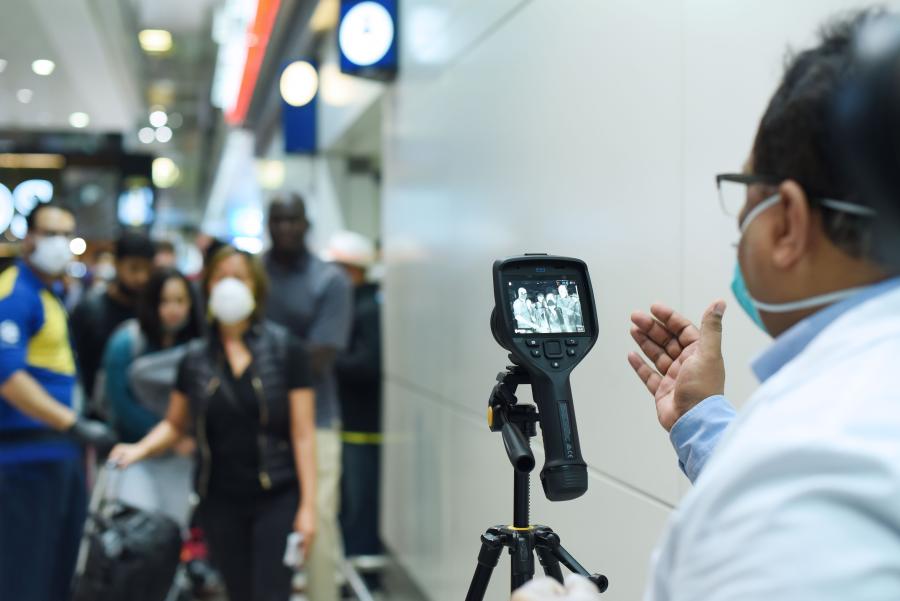Temperature Screening: This Season’s Newest Attraction?

In the wake of the coronavirus pandemic, some reopened parks and attractions in Asia have responded by screening guests’ temperatures. And, in a recent interview with Barron’s, Disney’s executive chairman, Bob Iger, referenced the possibility of taking guest temperature when the company’s parks reopen. Since one of the telltale symptoms of the disease is a fever, the process can help flag individuals who might have the illness. New to much of the industry, Funworld explores the implementation of body temperature screening.
By refusing entry to those who have high temperatures, parks and attractions can help prevent the spread of the disease and reassure visitors that their grounds and venues are safe. There are two categories of non-invasive tools available to assess temperatures: handheld infrared spot thermometers, often referred to as “thermometer guns,” and radiometric thermal imaging cameras. The devices, which have been deployed during previous viral outbreaks and are in use at airports, stores, and other checkpoints across the globe now, have their pros and cons.
“It’s a tradeoff between convenience and accuracy,” says John Honovich, president and founder of IPVM, one of the leading organizations that tests, researches, and reports on the video surveillance industry. He says that when used properly, handheld devices can provide reasonably accurate readings. But they require individual checks of each person. Perhaps more significant than the time needed to administer the one-on-one screenings is the proximity that the process requires between those being monitored and those conducting the checks. While there are non-contact devices on the market, they need to be held within about 2 to 6 inches of a person to get an accurate reading. “It increases the risk of either party coming into contact with one another,” Honovich notes.
Thermal cameras, on the other hand, can yield results from six feet away or more. They can passively indicate body temperature without placing an object up to a person, and some systems can be programmed to trigger an audible or visual alarm when they record an elevated reading. On the downside, Honovich says it can be hard for the cameras to determine accurate temperatures if people are moving or are positioned incorrectly. He also says ambient temperatures could trip up some systems. That is, if the outdoor background temperature is close to body temperature, it may be harder for the devices to get readings.
According to Honovich, the biggest supplier of thermal imaging cameras in the United States is FLIR. The company offers a variety of models that have been filed with the U.S. Food and Drug Administration (FDA) for use as body temperature screening tools. These include handheld units, cameras that can be mounted on tripods, ones that can be paired with laptops or other interface controls, and more permanent systems that can be affixed to ceilings or walls.
FLIR sells a thermometer gun through its subsidiary, Extech. But Chris Bainter, the company’s business development director, says that its line of thermal cameras record more points of temperature measurement and provide a better skin temperature profile. He adds that users can specify a region of interest on which the cameras can focus, such as people’s eyes.
“The best correlation to core body temperature is getting a measurement on the tear duct,” Bainter explains. Because the infrared devices cannot see through standard glass, those being screened would need to remove their eyewear.
Bainter says that users typically place a line on the floor where a camera is focused. Individuals are instructed to look at the camera and pause for a second. The results are almost instantaneous. While FLIR is working on technology that would allow multiple people to be measured at once, the company recommends that one person at a time be screened with its current systems. Bainter adds that FLIR’s thermal cameras are meant to work outdoors and can withstand hot, humid conditions.

Starting in late December, Legoland Japan began scanning its employees’ body temperatures using thermometer guns. The park closed February 29 amid the coronavirus outbreak. When Legoland reopened on March 23, it introduced temperature scans for its visitors as part of the security check process at the front gate.
According to Yukiko Hirano, head of PR, Legoland Japan is using Dr. Edison Non-Contact Thermometers. It is dedicating one person at each security checkpoint station to take temperatures by placing the devices alongside visitors’ necks or their arms.
“The process is quick,” Hirano says, noting that it takes no more than a few seconds to get a reading. “But security check is longer than normal operation.” Screeners would tell guests with temperatures higher than 37.5 degrees Celsius they that they could not enter the park and that they should contact healthcare providers for advice. Through March 31, no visitors coming to Legoland exhibited elevated temperatures.
So far, the temperature screening process has been going well. “Guests are agreeable,” says Hirano. “We have not had any complaints. Everyone understands the situation.”
Legoland considered thermal imaging cameras, but Hirano says that they were very expensive. FLIR’s models range from about $5,000 to $10,000 per camera. Its Extech IR200 thermometer gun retails for $149.99. The company says that there is high demand for its products and that there is a lead time of four to six weeks depending on models. Other manufacturers of thermal imaging cameras include ICI in the U.S. and DALI, Dahua, and Hikvision, all based in China.
All of the devices can produce false positives as well as false negatives for a variety of reasons and infected people can take several days to develop a fever. Also, people could mask fevers by taking medicine such as acetaminophen (Tylenol) or ibuprofen (Advil or Motrin). A portion of the population that has the disease remains asymptomatic, but contagious. So even when used properly and when producing accurate readings, be aware that no temperature screening system is foolproof in ruling out coronavirus.
